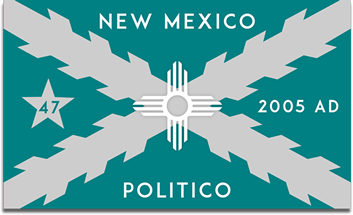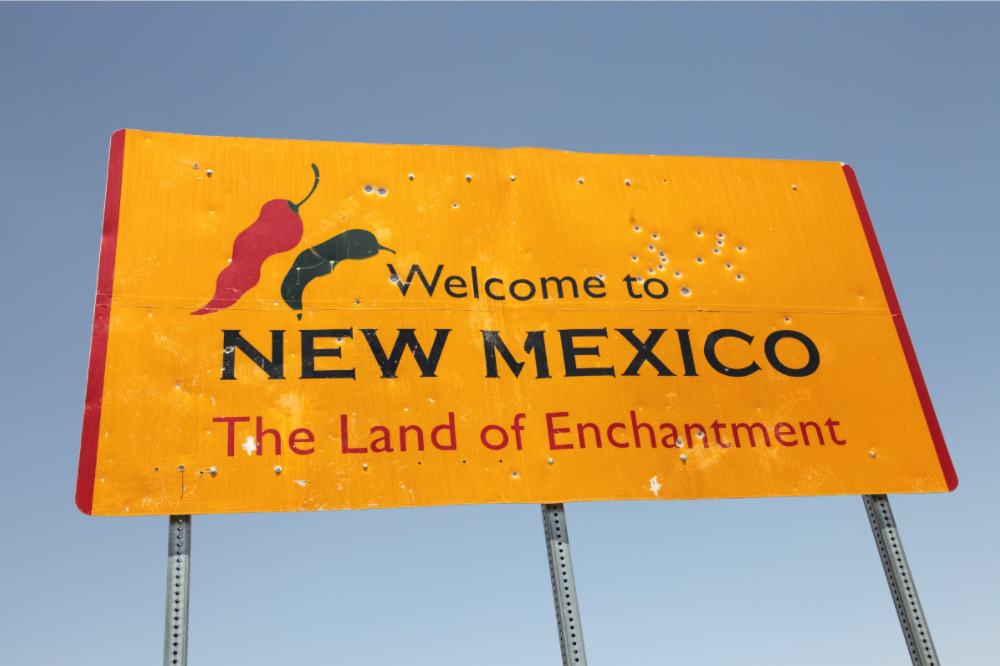With the Labor Day weekend behind us, the unofficial start of the general campaign season has arrived. The COVID-19 pandemic will impact the 2020 election cycle in a number of predictable and unpredictable ways, so with less than two months to go, here are six things to watch as we approach Election Day:
The Trump Effect
Being an incumbent running for reelection has well known advantages – including the power of the bully pulpit. Of the 45 who have held office, only ten presidents have failed to win re-election for a second term (when they have attempted to). Historically, all incumbents with an approval rating of 50% or higher have won reelection, and presidents with approval ratings much lower than 50% have lost. A Rasmussen poll from last Friday has Trump nationally at 52%, back to where he was prior to the start of the pandemic. In New Mexico, the Trump campaign has argued since early in the cycle that President Trump could flip the state for a number of reasons, chiefly among them a belief that most of Gary Johnson’s nine points in 2016 would transfer to him in 2020.
That has not happened. As revealed by the Albuquerque Journal a week ago, Biden sits at 54% and 39% support President Trump:
Biden’s commanding advantage in the Journal Poll was due largely to strong support among female voters, Hispanics and self-described moderates. Specifically, 67% of moderates, a category that includes Democrats, Republicans, independents and those affiliated with other political parties, said they would vote for Biden, compared with just 29% who said they would support Trump.
To no one’s surprise, Trump’s consistent weakness with moderates continues to impede his ability to close the gap in New Mexico. Indeed, Republicans who have found success in New Mexico effectively and deliberately branded themselves as moderates. President Trump’s scorched earth brand of politics turns off those outside the GOP base, and unless his generally weak support across the population centers improves, it does not bode well for those GOP candidates down ballot who are in competitive races – such as Herrell in NM CD-2.
Hispanic Support
As confirmed by the Journal Poll, Hispanic voters are breaking strongly for Biden by a ratio of more than 2-to-1, with 64 percent of Hispanic voters saying they would vote for Biden and just 28 percent for Trump. Since the 2020 Primary Election Joe Biden has had relatively strong Hispanic support so it is not surprising that his numbers are stronger than Hillary Clinton’s 2016 New Mexico Hispanic support of 54 points to Trump’s 33 points.
Ironically, Biden’s Hispanic support nationally is underperforming relative to Clinton’s 2016 numbers: she won an estimated 66 percent of Hispanic voters while Biden appears to be earning between 45 percent and 64 percent of Latino support nationally. Chuck Rocha, the architect behind Sen. Sanders securing the most votes among Hispanics during the Nevada, Texas, and California primaries worries that the Biden campaign is taking Hispanic support for granted, and that his weak Hispanic support nationally can be attributed “due to a lack of investment in Latino outreach”.
On the other hand, the GOP has historically struggled to engage with Hispanic voters – and New Mexico, having the highest Hispanic share of the electorate at 40 percent, is ground zero for this lack of engagement. Tragically, Hispanics in New Mexico are likely to be largely ignored by both sides: taken for granted by the Democrats and abandoned by the GOP. And on top of the lack of meaningful engagement by either side, the pandemic “may depress [Hispanic] voter interest in an election that seems disconnected from many communities’ dire situations.”
Enthusiasm Gap & Demographics
Similar to the 2018 midterms, there is a concern that while Trump’s base of support is strong, there is a “anybody but Trump” sentiment that has and will continue to fuel turnout against the GOP:
A Fox News poll asked respondents what was motivating them more: enthusiasm for their candidate to win, or fear the other candidate will prevail. By an 18-point margin, Biden voters say they are more afraid that Trump will win (57 percent) than enthusiastic about Biden becoming president (39 percent).
What is keeping Trump’s supporters up at night is that this anti-Trump coalition has crossed into demographic groups that historically favored the GOP. A recent NBC News/Wall Street Journal poll showed Biden leading Trump by 7 points among voters 65 and older:
Biden holds advantages of 80 points among Black voters, 26 points among Hispanic voters and 7 points among those 65 or older, while Trump has a lead of 51 points among white, evangelical voters and 24 points among white voters without a college degree:https://t.co/aZYFfLlCO8 pic.twitter.com/uLrKpGVWDn
— John McCormick (@McCormickJohn) August 16, 2020
That same poll revealed Biden with a roughly 2-to-1 lead among self-identified independent voters, another group that nationally leaned Trump in 2016. In New Mexico districts where Republicans are in the minority in voter registration numbers (which is basically everywhere except “Little Texas” and the NW corner of the state) these numbers are a serious problem.
Trump has also accelerated a trend that has long plagued the GOP, where shifting demographics are broadly eroding GOP support. Growing young minority populations, concentrated in the Southwest and South, are steadily diminishing GOP support in states that have been reliably red.
Young voter support of the GOP is a demographic that has also been trending lower in recent years, but the shift even from just 2016 has been pretty dramatic as evident in this poll from Pennsylvania:
Who’s driving Joe Biden’s 9 point lead in our new poll of PA likely voters? One group that’s showing a big shift from 2016 is voters under 45 years old. Dig into other cross-tabs here: https://t.co/p9LtqvCrHa pic.twitter.com/ABFUvmL8Gc
— Marist Poll (@maristpoll) September 10, 2020
Political & Pandemic Environment
Political predictions in a year of such uncertainty seem rather futile, but one of the things that most political pundits agree on is that the blowout presidential race of 2016 is unlikely to be repeated, and as we approach fall the race will tighten, and numerous signals have and will continue to emerge that confirm that sentiment. The race’s shift from the coronavirus to concerns about law and order has benefited Trump; the rioting in some U.S. cities has been a “blind spot” for Democrats, so expect Biden and other Democrats to come out more strongly in opposition to the rioting. You can be sure that Democrats in New Mexico paid attention to the same Journal Poll previously mentioned which revealed 74% of voters support “the way the police in their communities are doing their jobs.” Continued unrest and rioting and/or a fall resurgence of coronavirus cases are externalities that could affect voter sentiment as Election Day approaches.
Political campaigns will also have to contend with an anticipated and unprecedented surge in mail-in and early voting. In New Mexico, county clerks may begin to mail absentee ballot requests to all registered voters as early as September 14th and will begin to mail ballots to those who requested them as early as October 6th. Remember that although there was a push by Democrat Secretary of State Maggie Toulouse Oliver and some county clerks to automatically mail out ballots to all registered voters, the New Mexico Supreme Court ruled unanimously against that idea saying it was against New Mexico statute. Still, with absentee voting likely to reach unprecedented levels in New Mexico, campaigns will have to adapt their GOTV strategies accordingly.
D.C. Influence & Impact
Unless Biden’s relatively strong New Mexico numbers shift significantly, New Mexico is unlikely to see a major infusion of D.C. cash in support of the Biden campaign (though with Biden’s strong fundraising numbers they might still have enough to spread it around). On the flip side, even though the Trump campaign has spent considerably (compared to 2016) in creating and supporting a GOTV field staff in the state, the campaign might have to spend resources defending historically reliable GOP states (Arizona) as well as other swing states that will likely decide the 2020 election.
Control of the U.S. Senate is also a concern for the GOP, with Democrats needing a net total of three seats and the White House or four seats for an outright majority. The reason this affects New Mexico is that McConnell and the GOP is having to defend numerous vulnerable members – including McSally in Arizona, Gardner in Colorado, and Tillis in North Carolina – meaning the GOP does not have the luxury of playing offense and play in a race like the one in New Mexico for a rare open seat between Mark Ronchetti and Ben Ray Luján. Ben Ray, a rather untested candidate, is no doubt intimidated by Mark’s strong television presence as evidenced by his avoiding a KOB-TV and Santa Fe New Mexican debate on October 5th. While BRL campaign’s decision to “play it safe” makes sense from a purely political calculation, it is unfortunate New Mexicans will miss out on the opportunity to hear directly from both candidates. Without D.C. support or some major unforced error by BRL, there is no calvary coming to support Ronchetti, and the rest of the GOP candidates will miss out on potentially riding on Mark’s coattails come November.
NM GOP Strategy
The ability for the Republicans in New Mexico to self-inflict damage and permit infighting to permeate the party’s overall effectiveness is rather unfortunate, if not impressive. The most recent example is NM GOP Chairman Pearce and other GOP leadership last month calling for the firing of Ryan Flynn, head of the New Mexico Oil and Gas Association. Frankly, Flynn is just doing his fiduciary duty to the organization by expanding its influence beyond a GOP that is at its least powerful or influential in recent history. The smart money in “Little Texas” knows this, and the public spat only hurts the candidates who would benefit from greater cooperation from the some of the largest GOP-friendly donors in New Mexico.
Beyond the infighting some credit is due to the NM GOP for both the voter engagement infrastructure Pearce has built and the moderate-branded “Respect New Mexico” marketing campaign – regardless of whether or not the NM GOP really believes “campaigns don’t start until after Labor Day” or – as I believe is the case – they were just struggling to change the narrative of Trump’s poor polling results:
The recently released summer presidential poll by the @ABQJournal offers little believability before campaigns gear up for their post-Labor Day blitz. Read the official release: https://t.co/XzPUGh5nDK pic.twitter.com/zbvdUh8Fio
— Republican Party of New Mexico (@NewMexicoGOP) September 6, 2020
But the success of both efforts has a couple of unintended negative side effects. First, the voter engagement infrastructure is almost entirely built for and funded by the Trump campaign whose first and only priority is turning out Trump voters – which means the concerns of down ballot candidates are secondary. Second, the “Respect New Mexico” campaign has sucked up a lot of the resources that would otherwise be donated directly to candidates. Such an organization might be able to gain some economies of scale, though there is a risk in a “jack of all trades, master of none” approach where direct voter mobilization is not the sole focus of the effort.
The idea of a centralized effort sounds great in theory, but it remains to be seen how effective it will be in the only metric that matters come Election Day: voter turnout. The results in November will reveal if they are on to something or will further amplify calls for a change in GOP leadership. Regardless of the outcome, if the GOP locally and nationally does not address the growing demographic concerns plaguing the electoral success of the party, the future of the GOP will remain in doubt.

